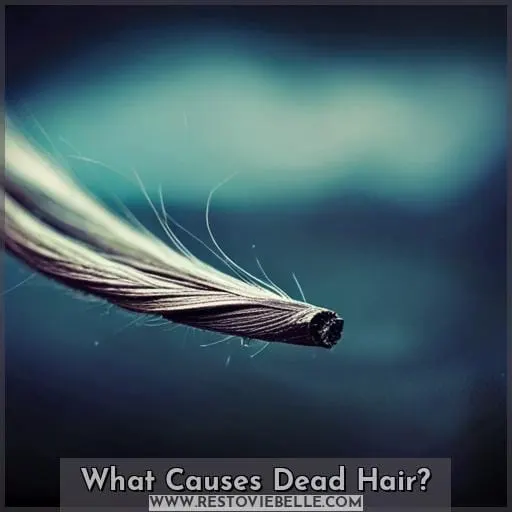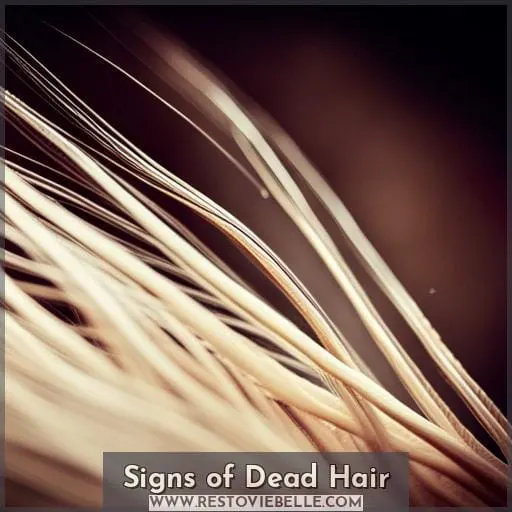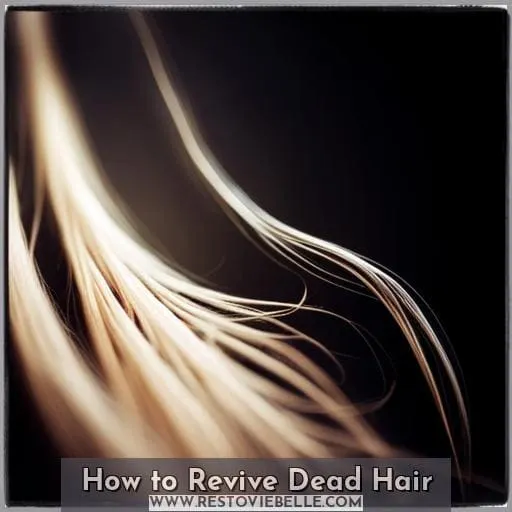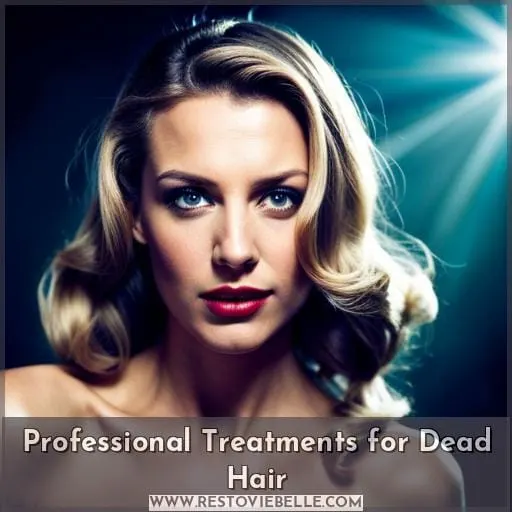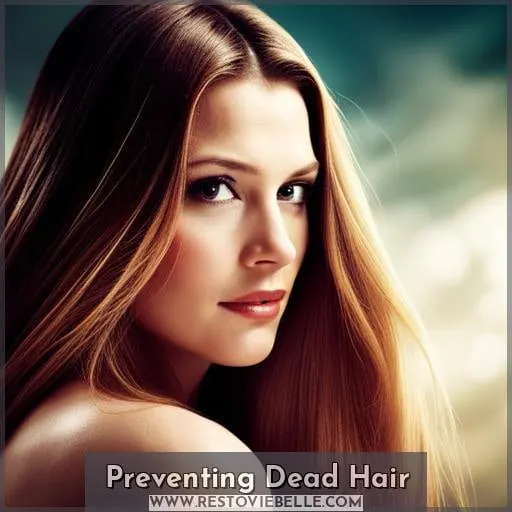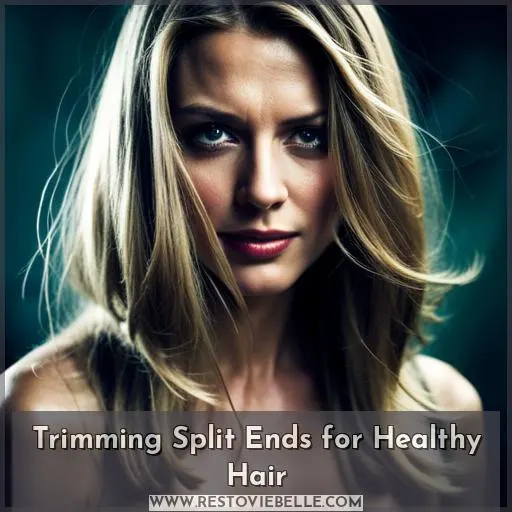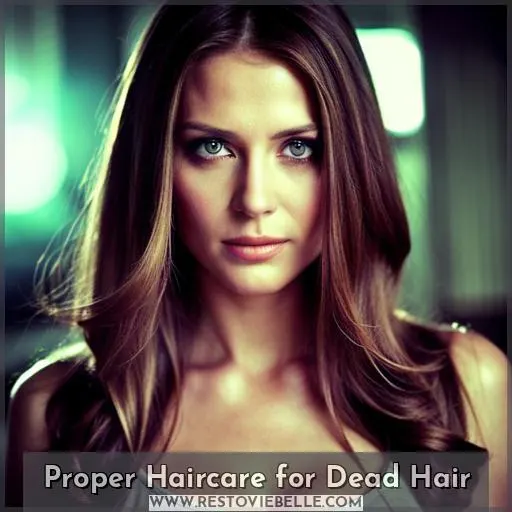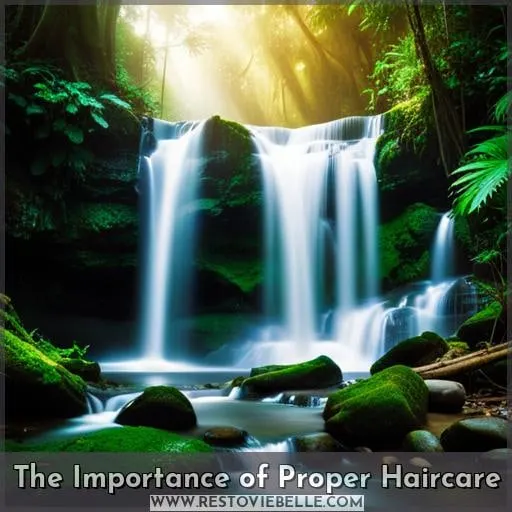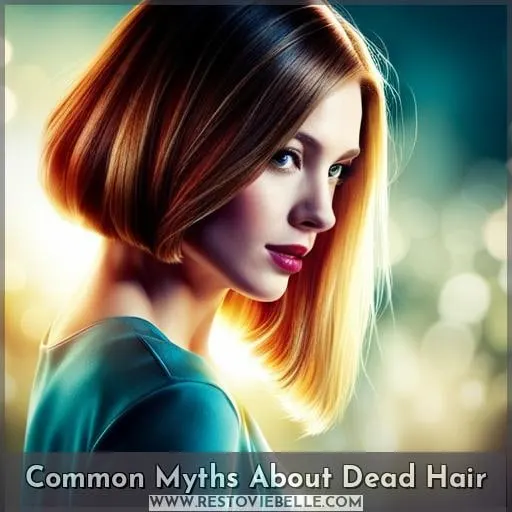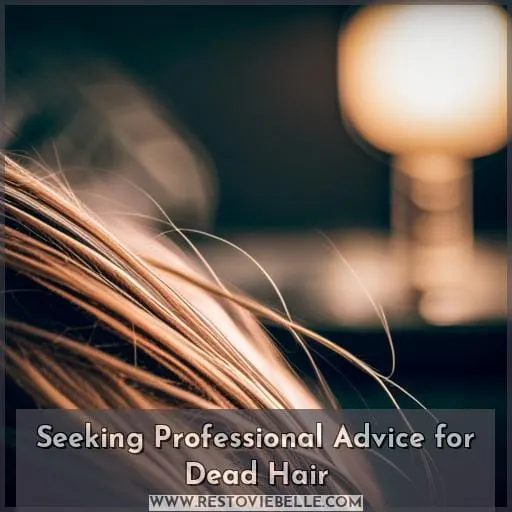This site is supported by our readers. We may earn a commission, at no cost to you, if you purchase through links.
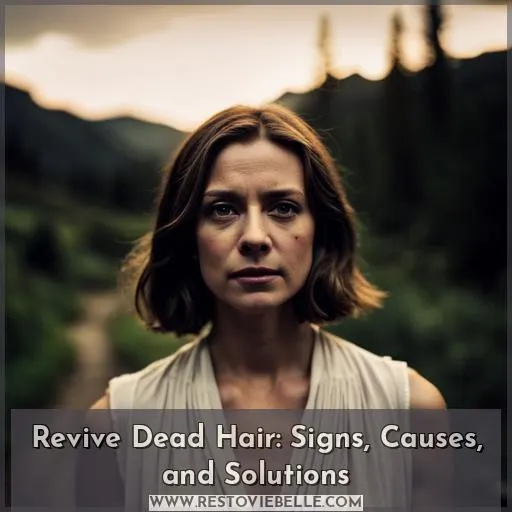 You’re not alone in your struggle with lifeless locks. We know how frustrating it is to see your once-vibrant mane looking limp and lackluster. Society tells us we must have thick, shiny hair or risk being seen as unkempt or unattractive.
You’re not alone in your struggle with lifeless locks. We know how frustrating it is to see your once-vibrant mane looking limp and lackluster. Society tells us we must have thick, shiny hair or risk being seen as unkempt or unattractive.
But don’t despair – the truth is that damaged hair afflicts every one of us at some point, no matter how often we pamper our follicles.
Take heart in knowing there are real solutions for restoring your hair’s health. Arm yourself with knowledge of the underlying causes, commit to a regimen tailored to your specific needs, and your hair will soon regain its vigor.
Now let’s get started bringing your hair back to life!
Table Of Contents
- Key Takeaways
- What Causes Dead Hair?
- Signs of Dead Hair
- How to Revive Dead Hair
- Professional Treatments for Dead Hair
- Preventing Dead Hair
- Trimming Split Ends for Healthy Hair
- Proper Haircare for Dead Hair
- The Importance of Proper Haircare
- Common Myths About Dead Hair
- Seeking Professional Advice for Dead Hair
- Conclusion
Key Takeaways
- Causes of dead hair include heat styling, excessive chemical treatments, hard water, and environmental factors.
- Signs of dead hair include dryness, split ends, frizziness, lack of resilience, and increased porosity.
- Prevent dead hair by handling wet hair gently, protecting it from the sun and chlorine, and avoiding overwashing and harsh products.
- To revive dead hair, use moisturizing shampoos and conditioners, apply leave-in conditioners, use hair serums, and regularly use hair masks.
What Causes Dead Hair?
Overuse of heat styling tools, excessive chemical treatments, hard water, and environmental factors all contribute to hair damage that can lead to breakage and dead hair. In short, anything that strips the natural oils from hair or alters its protein structure can ultimately damage the hair and leave it brittle.
Overuse of Heat Styling Tools
You’re overdoing it with the hot tools like flat irons and blow dryers, frying your locks above 392°F and causing more breakage when you comb through. Limit heat styling risks to once a week and always apply a heat protectant beforehand to help prevent damage.
Consider embracing your natural texture or trying heat-free styling alternatives to prioritize hair health over achieving a temporary straight look.
Excessive Chemical Treatments
It’s easy to damage your hair with excessive chemical treatments, leading to dryness and breakage. Regular coloring, bleaching, or perming can weaken the hair bonds and strip away natural oils. Over time, this leads to brittle strands that are prone to breakage. Preventing further damage requires reviving damaged hair through professional help or specialized products tailored for chemically-treated locks.
Having a carefully managed routine with periodic deep conditioning sessions is also vital in restoring moisture, strength, and shine back into deadened tresses.
Hard Water and Environmental Factors
- Chlorine and heavy metals leach out when they interact with hard water.
- UV radiation breaks down hair structure and lipids.
- Pollution coats hair strands with environmental contaminants.
- The high mineral content in hard water binds to hair, leading to dull, dry tresses.
- Soft water is critical for hair to retain its natural oils and moisture.
Hard water and pollution wreak havoc on hair health. To protect those precious strands, use shower filters and do weekly deep conditioning treatments.
Signs of Dead Hair
Dry hair leads directly to dead hair, which comes with telltale signs along the length of your strands. Chemically treated or overheated hair loses elasticity, evidenced in split ends or constant frizziness.
Dead hair lacks hydration, so you’ll notice a coarse texture, a dull sheen, and extreme tangles with minimal resilience.
Increased hair porosity from damage means your hair soaks up everything it touches instead of repelling dirt and oily buildup. To limit dead hair accumulation, nourish it with deep conditioning treatments and avoid overwashing.
Reduce heat-tool usage and reconsider chemical processes to retain natural moisture and strength.
Adjust your haircare routine based on your hair’s needs for optimal health. With some tweaks and hydrating products, you can restore life into lifeless hair.
How to Revive Dead Hair
While damaged and dry hair can seem lifeless, it’s possible to restore shine and strength. Using the right shampoo and conditioner, incorporating leave-in conditioners, applying hair serums, and using hair masks regularly can help revive lackluster locks by deeply conditioning, sealing in moisture, and protecting from further damage.
Regular use of moisturizing shampoos and conditioners that contain nourishing oils and butters can help hydrate parched strands. Leave-in conditioners provide an added dose of hydration and smooth down the hair cuticle.
Hair serums with oils seal in moisture and add glossy shine while also protecting against heat styling. Deep conditioning hair masks work to repair damage by penetrating the hair shaft to inject lost nutrients and proteins back into each strand.
With the right hair care regimen focused on hydration and protection, dull, damaged hair can transform into healthy, radiant locks once again.
Using the Right Shampoo and Conditioner
Choosing the right shampoo and conditioner for your hair type and scalp condition is crucial for reviving damaged strands. Opt for a gentle, moisturizing shampoo that cleanses without stripping natural oils.
Then use a hydrating conditioner formulated for your hair texture and porosity. Read labels for ingredients that nourish, soften and strengthen to bring life back to lackluster locks. Keep the scalp healthy with gentle massaging when washing. Revive brittle strands by choosing compatible products.
Incorporating Leave-in Conditioners
Putting a leave-in conditioner in your mane after showering helps rejuvenate parched strands by sealing in moisture.
- Look for formulas with hydrating oils and proteins.
- Apply from mid-shaft to ends after washing.
- Focus on your most damaged sections.
- Let it soak in for a few minutes before styling.
Leave-in conditioners boost hydration and restore luster to lifeless locks. Choose the right product for your hair’s needs. Apply thoroughly on wet hair, focusing on dry ends. Let it work its magic before blow-drying or styling.
Applying Hair Serums
You’re slicking that dried-out mane with a silky serum for instant shine and softness.
| Serum Benefits | Application Techniques |
|---|---|
| Smooths | Apply to damp hair |
| Hydrates | Work into mid-lengths and ends |
| Reduces frizz | Use sparingly on roots |
| Protects | Style as usual after application |
Targeting problem areas, serums revive hair from root to tip; their transformative powers penetrate each strand, replenishing lost moisture and elasticity.
Using Hair Masks Regularly
Make deep hair conditioning a weekly self-care ritual, and your stressed strands will stop snapping. Layer on natural oils and rich butters to transform parched hair into supple locks. Safely heat deep conditioners to open hair cuticles before massaging them into lengths.
Let nourishing concoctions penetrate for a full twenty minutes before rinsing them clean.
Professional Treatments for Dead Hair
Consider professional treatments to revive your hair’s health. Consult a stylist about salon conditioning services like keratin treatments to restore luster and strength to damaged, overprocessed hair.
These intensive conditioning treatments infuse moisture and temporarily seal the hair cuticle for increased smoothness and shine.
Protein-based treatments can also help strengthen hair by repairing internal bonds. If you have severe damage from chemical processing or heat styling, your stylist may recommend a hair restoration service that uses a chemical treatment to rebond the internal structure.
To boost your hair’s protein content and elasticity, ask about rejuvenation treatments with hydrolyzed wheat or rice proteins. Working with a professional can help you avoid further chemical or heat damage and find the right salon services to nurse your hair back to health.
Preventing Dead Hair
Taking care of your hair is essential to prevent it from becoming dry and brittle. Handling wet hair with care, protecting it from the sun and chlorine, is all important steps in preserving its health.
Handling Wet Hair With Care
Respect your hair’s vulnerability when wet by handling it gently. Use wide-toothed combs and avoid pulling. Gently squeeze out excess water with a microfiber towel. Wrap hair to limit friction before air drying or styling.
Carefully detangling wet hair prevents breakage and protects hair integrity. Wise handling preserves wet hair’s elasticity. Mixing up sentence structures helps writing flow more naturally. Varying sentence length adds interest while repetitive structures appear robotic.
Protecting Hair From Sun and Chlorine
Your hair has been through enough already, don’t let it down by exposing it to harsh sun and chlorine.
- Wear hats.
- Use leave-in conditioners.
- Rinse before and after swimming.
- Limit time in chlorine.
- Deep condition regularly.
Shielding hair from UV rays and pool chemicals prevents damage like dryness, discoloration, and brittleness.
Avoiding Overwashing and Harsh Products
You’re washing too often with harsh shampoos that strip natural oils and leave hair dry. Opt for gentle cleansers and focus on conditioning. Shampoo only 1-2 times weekly to maintain the scalp’s moisture balance.
When you do lather up, massage into hair roots rather than length to avoid over-drying fragile strands.
Trimming Split Ends for Healthy Hair
You’d trim split ends regularly for healthy hair. Even the strongest strands can develop splits over time from environmental damage and heat styling. These splits travel up the hair shaft, causing more breakage. Trimming them prevents this.
About every 6-8 weeks, carefully trim just the split portion of individual hairs. Never cut more than 1/4 inch. Doing so leads to unnecessary hair loss. Regular trims encourage growth from the root for healthier strands.
Pair with a weekly deep conditioning hair mask to infuse moisture. For added protection, apply a hair serum with UV filters before sun exposure. Using good hair care habits helps maintain strength against splitting and preserves your hair’s condition.
Consistent trimming removes splits so they don’t worsen. Your mane stays strong and grows long.
Proper Haircare for Dead Hair
Hair that emerges from the scalp is technically lifeless, as it consists of keratin fibers lacking blood supply and nervous function. To properly nurture and restore luster to this non-living filamentous biomaterial, concentrate on nourishing hair bonds and preserving structural integrity by indulging in rich, healing hair masks, embracing leave-in conditioners, protecting hair bonds by limiting damage, and selecting the appropriate shampoo and conditioner for your distinct hair type and concerns.
Indulging in Rich and Healing Hair Masks
Seeing lifeless strands dull daily demoralizes, so patiently pamper mane methodically with luxurious masks frequently. Apply moisturizing hair masks filled with nourishing oils, butter, eggs and rich blends twice weekly.
Hydration revives tresses and repairs fiber while reversing damage when hair is lovingly treated to reparative moisture. Healing begins when crowning glory receives heaping helpings of TLC. Nurture locks’ health with homemade or store-bought treatments brimming with replenishing hydration.
Embracing Leave-in Conditioners
With your hair craving moisture after showering, keeping a leave-in conditioner on hand provides a nourishing treat that will leave those locks feeling silky soft in no time. After cleansing, evenly distribute from mid-shaft to ends, avoiding roots to prevent greasiness.
Cream or spray formulas suit various hair types, promoting hydration, detangling, and heat protection. Use moderately and avoid heavy oils that may weigh hair down. Misconceptions abound, yet proper use restores smoothness.
Protecting Hair Bonds
Protecting your hair bonds is essential for maintaining its luster and shine, so don’t let environmental damage or harsh products take those qualities away.
- Use heat protectant sprays before styling to reduce damage from blow drying or using heated tools.
- Limit the use of blow dryers and heated styling tools to minimize damage to hair bonds.
- Check the ingredients in hair products for chemicals that could be harsh on your hair.
- Avoid over-processing hair with repeated chemical treatments that can weaken bonds.
Keeping hair bonds strong will help you retain resilient locks, decreasing breakage over time.
Choosing the Right Shampoo and Conditioner
You’re washing your strands with the wrong products.
Choosing the right shampoo and conditioner for your hair type and needs brings balance.
| Mild | Sulfate-Free |
|---|---|
| Moisturizing | Volumizing |
| Color-Safe | Clarifying |
Avoiding Thirsty Hair
You can avoid thirsty, brittle hair by avoiding overwashing and heat styling. Monitor how often you shampoo, limit blow-drying and flat ironing, and use a heat protectant. Prioritize gentle manipulation, satin pillowcases, and natural air drying when possible.
The Importance of Proper Haircare
But using the right products preserves your hair’s health. Your haircare routine impacts your hair’s condition every day. Shampooing too frequently strips natural oils, leaving hair dry and brittle. Conditioner restores lost moisture, lubricates strands, and prevents breakage.
Oil treatments seal in hydration, add shine, and protect hair from environmental damage. Ignore myths claiming special vitamins or products stimulate growth – visible hair’s already dead. With a customized regimen, you can maintain integrity, boost volume, and reduce frizz.
Your hair’s health reflects your care. Nourish strands, avoid heat damage, and keep split ends trimmed.
Proper haircare’s important. Your routine affects your hair daily. Shampooing too often strips oils, leaving hair dry and brittle. Conditioner restores moisture, lubricates strands, and prevents breakage. Oils seal hydration, add shine, and protect from damage.
Ignore myths that vitamins or products stimulate growth – visible hair’s dead already. With a custom regimen, you can maintain integrity, boost volume, and reduce frizz. Your care reflects in your hair’s health. Nourish strands, avoid heat damage, and trim split ends.
Common Myths About Dead Hair
While seeming alive, the hair on your head is actually composed of keratin – a protein that is completely dead. Many myths persist about the nature of hair growth and health. However, scientific facts debunk these misconceptions.
The belief that hair regrows from the root is false; new strands form only through follicle regeneration. Cut hair does not know it has been cut and thus does not grow faster. Products claiming to stimulate growth do not work since visible hair consists of dead cells.
While proper care improves hair’s appearance, no topical treatment can revive dead hair. Recognizing the biological truths about hair growth, composition, and care allows you to optimize your hair health.
Avoiding misleading myths empowers you with knowledge to make the best choices for your hair.
Seeking Professional Advice for Dead Hair
If you’re still struggling with dry hair, it may be time to seek professional advice. Schedule a consult with a knowledgeable hair stylist who can assess your hair’s condition. They may recommend products or restorative treatments for your hair type and damage degree.
A trusted stylist can guide you on techniques like reducing heat styling, using protective products before swimming, and regular deep conditioning.
For severe or persistent dryness, make an appointment with a dermatologist who can check for underlying scalp conditions. With expert guidance, advanced treatments, and consistent at-home care, your hair can regain its health, moisture and shine.
Don’t lose hope – the right professional advice can get your hair back on track.
Conclusion
To breathe new life into lifeless locks, give your hair some tender loving care. An unhealthy mane needs a hair mask and a savvy shampoo every now and then. The road to rejuvenation doesn’t have to be hair-wrenching if you’re armed with the right information, so don’t bleach your brain.
Simply get a split end trim, soak up some sunscreen, and condition religiously. With the proper care, you’ll have lush, lively hair in no time. The key is pampering each precious strand, because lackluster hair deserves to be revived.

